Evaluation and Inter-Comparison of Satellite Soil Moisture Products Using In Situ Observations over Texas, U.S.
Abstract
:1. Introduction
2. Materials and Methods
2.1. Study Region
2.2. Remotely-Sensed Data
2.2.1. AMSR-E Soil Moisture
2.2.2. SMOS Soil Moisture
2.2.3. AMSR2 Soil Moisture
2.2.4. SMAP Soil Moisture
2.2.5. MODIS Data
2.3. In Situ Measurements
2.4. Analysis Methods
3. Results
3.1. Evaluation Using Spatial Variation
3.2. Evaluation Using Temporal Variation
4. Discussion
5. Conclusions
Acknowledgments
Author Contributions
Conflicts of Interest
References
- Seneviratne, S.I.; Corti, T.; Davin, E.L.; Hirschi, M.; Jaeger, E.B.; Lehner, I.; Orlowsky, B.; Teuling, A.J. Investigating soil moisture-climate interactions in a changing climate: A review. Earth-Sci. Rev. 2010, 99, 125–161. [Google Scholar] [CrossRef]
- Al Bitar, A.; Leroux, D.; Kerr, Y.H.; Merlin, O.; Richaume, P.; Sahoo, A.; Wood, E.F. Evaluation of SMOS Soil Moisture Products Over Continental US Using the SCAN/SNOTEL Network. IEEE Trans. Geosci. Remote Sens. 2012, 50, 1572–1586. [Google Scholar] [CrossRef]
- Griesfeller, A.; Lahoz, W.A.; de Jeu, R.A.M.; Dorigo, W.; Haugen, L.E.; Svendby, T.M.; Wagner, W. Evaluation of satellite soil moisture products over Norway using ground-based observations. Int. J. Appl. Earth Obs. Geoinf. 2016, 45, 155–164. [Google Scholar] [CrossRef]
- Xiao, Z.; Jiang, L.; Zhu, Z.; Wang, J.; Du, J. Spatially and Temporally Complete Satellite Soil Moisture Data Based on a Data Assimilation Method. Remote Sens. 2016, 8. [Google Scholar] [CrossRef]
- Huszar, T.; Mika, J.; Loczy, D.; Molnar, K.; Kertesz, A. Climate change and soil moisture: A case study. Phys. Chem. Earth Part A Solid Earth Geod. 1999, 24, 905–912. [Google Scholar] [CrossRef]
- Li, H.B.; Robock, A.; Wild, M. Evaluation of Intergovernmental Panel on Climate Change Fourth Assessment soil moisture simulations for the second half of the twentieth century. J. Geophys. Res.-Atmos. 2007, 112. [Google Scholar] [CrossRef]
- Collow, T.W.; Robock, A.; Basara, J.B.; Illston, B.G. Evaluation of SMOS retrievals of soil moisture over the central United States with currently available in-situ observations. J. Geophys. Res.-Atmos. 2012, 117, D09113. [Google Scholar] [CrossRef]
- Dorigo, W.A.; Wagner, W.; Hohensinn, R.; Hahn, S.; Paulik, C.; Xaver, A.; Gruber, A.; Drusch, M.; Mecklenburg, S.; van Oevelen, P.; et al. The International Soil Moisture Network: A data hosting facility for global in-situ soil moisture measurements. Hydrol. Earth Syst. Sci. 2011, 15, 1675–1698. [Google Scholar] [CrossRef]
- Wagner, W.; Dorigo, W.; de Jeu, R.; Fernandez, D.; Benveniste, J.; Haas, E.; Martin, E. Fusion of active and passive microwave observations to create an essential climate variable data record on soil moisture. ISPRS Ann. Photogramm. Remote Sens. Spat. Inf. Sci. 2012, 315–321. [Google Scholar] [CrossRef]
- Henderson-Sellers, A. Soil moisture: A critical focus for global change studies. Globa. Planet. Chang. 1996, 13, 3–9. [Google Scholar] [CrossRef]
- Korres, W.; Reichenau, T.G.; Schneider, K. Patterns and scaling properties of surface soil moisture in an agricultural landscape: An ecohydrological modeling study. J. Hydrol. 2013, 498, 89–102. [Google Scholar] [CrossRef]
- Schoonover, J.E.; Crim, F. An introduction to soil concepts and the role of soil in watershed management. J. Contemp. Water Resear. Educ. 2015, 154, 21–47. [Google Scholar] [CrossRef]
- Fares, A.; Temimi, M.; Morgan, K.T.; Kelleners, T.J. In-situ and remote soil moisture sensing technologies for vadose zone hydrology. Vadose Zone J. 2013, 12. [Google Scholar] [CrossRef]
- Temimi, M.; Lakhankar, T.; Zhan, X.; Cosh, M.H.; Krakauer, N.; Fares, A.; Kelly, V.; Khanbilvardi, R.; Kumassi, L. Soil moisture retrieval using ground-based L-band passive microwave observations in Northeastern USA. Vadose Zone J. 2014, 13. [Google Scholar] [CrossRef]
- GCOS. Systematic observation requirements for satellite based data products for climate. GCOS 2011, 154, 1–127. [Google Scholar]
- Brocca, L.; Hasenauer, S.; Lacava, T.; Melone, F.; Moramarco, T.; Wagner, W.; Dorigo, W.; Matgen, P.; Martinez-Fernandez, J.; Llorens, P.; et al. Soil moisture estimation through ASCAT and AMSR-E sensors: An intercomparison and validation study across Europe. Remote Sens. Environ. 2011, 115, 3390–3408. [Google Scholar] [CrossRef]
- Notarnicola, C.; Caporaso, L.; Giuseppe, F.D.; Temimi, M.; Ventura, B.; Zebisch, M. Inferring soil moisture variability in the Mediterrean Sea area using infrared and passive microwave observations. Can. J. Remote Sens. 2012, 38, 46–59. [Google Scholar] [CrossRef]
- Nicolai-Shaw, N.; Hirschi, M.; Mittelbach, H.; Seneviratne, S.I. Spatial representativeness of soil moisture using in-situ, remote sensing, and land reanalysis data. J. Geophys. Res.-Atmos. 2015, 120, 9955–9964. [Google Scholar] [CrossRef]
- Kumar, S.V.; Peters-Lidard, C.D.; Mocko, D.; Reichle, R.; Liu, Y.; Arsenault, K.R.; Xia, Y.; Michael, E.K.; George, R.; Livneh, B.; et al. Assimilation of remotely sensed soil moisture and snow depth retrievals for drought estimation. J. Hydrometeorol. 2014, 15, 2446–2469. [Google Scholar] [CrossRef]
- Lakhankar, T. Estimation of Soil Moisture Using Microwave Remote Sensing Data. Ph.D. Thesis, The City University of New York, New York, NY, USA, 2006. [Google Scholar]
- Dorigo, W.; de Jeu, R.; Chung, D.; Parinussa, R.; Liu, Y.; Wagner, W.; Fernandez-Prieto, D. Evaluating global trends (1988–2010) in harmonized multi-satellite surface soil moisture. Geophys. Res. Lett. 2012, 39, 18405. [Google Scholar] [CrossRef]
- Vinnikov, K.Y.; Robock, A.; Qiu, S.A.; Entin, J.K.; Owe, M.; Choudhury, B.J.; Hollinger, S.E.; Njoku, E.G. Satellite remote sensing of soil moisture in Illinois, United States. J. Geophys. Res. Atmos. 1999, 104, 4145–4168. [Google Scholar] [CrossRef]
- Reichle, R.H.; Koster, R.D.; Dong, J.R.; Berg, A.A. Global soil moisture from satellite observations, land surface models, and ground data: Implications for data assimilation. J. Hydrometeorol. 2004, 5, 430–442. [Google Scholar] [CrossRef]
- Wen, J.; Jackson, T.J.; Bindlish, R.; Hsu, A.Y.; Su, Z.B. Retrieval of soil moisture and vegetation water content using SSM/I data over a corn and soybean region. J. Hydrometeorol. 2005, 6, 854–863. [Google Scholar] [CrossRef]
- Njoku, E.G.; Entekhabi, D. Passive microwave remote sensing of soil moisture. J. Hydrol. 1996, 184, 101–129. [Google Scholar] [CrossRef]
- Das, K.; Paul, P.K. Present status of soil moisture estimation by microwave remote sensing. Cogent Geosci. 2015, 1, 1–21. [Google Scholar] [CrossRef]
- Chaouch, N.; Leconte, R.; Magagi, R.; Temimi, M.; Khanbilvardi, R. Multi-Stage inversion method to retrieve soil moisture from passive microwave measurements over the Mackenzie River Basin. Vadose Zone J. 2013, 12. [Google Scholar] [CrossRef]
- Lakhankar, T.; Krakauer, N.; Khanbilvardi, R. Applications of microwave remote sensing of soil moisture for agricultural applications. Int. J. Terraspace Sci. Eng. 2009, 2, 81–91. [Google Scholar]
- Lakshmi, V. Remote sensing of soil moisture. ISRN Soil Sci. 2013, 2013. [Google Scholar] [CrossRef]
- Jackson, T.J. Soil moisture estimation using special satellite microwave/imager satellite data over a grassland region. Water Resour. Res. 1997, 33, 1475–1484. [Google Scholar] [CrossRef]
- Jackson, T.J.; Cosh, M.; Bindlish, R.; Starks, P.J.; Bosch, D.D.; Seyfried, M.; Goodrich, D.C.; Moran, M.S. Validation of advanced microwave scanning radiometer soil moisture products. IEEE Trans. Geosci. Remote Sens. 2010, 12, 4256–4272. [Google Scholar] [CrossRef]
- Champagne, C.; McNairn, H.; Berg, A.A. Monitoring agricultural soil moisture extremes in Canada using passive microwave remote sensing. Remote Sens. Environ. 2011, 115, 2434–2444. [Google Scholar] [CrossRef]
- Colliander, A.; Jackson, T.J.; Bindlish, R.; Chan, S.; Das, N.; Kim, S.B.; Cosh, M.H.; Dunbar, R.S.; Dang, L.; Pashaian, L.; et al. Validation of SMAP surface soil moisture products with core validation sites. Remote Sens. Environ. 2017, 191, 215–231. [Google Scholar] [CrossRef]
- Cheng, W.Y.Y.; Cotton, W.R. Sensitivity of a cloud-resolving simulation of the genesis of a mesoscale convective system to horizontal heterogeneities in soil moisture initialization. J. Hydrometeorol. 2004, 5, 934–958. [Google Scholar] [CrossRef]
- Venkataraman, K.; Tummuri, S.; Medina, A.; Perry, J. 21st century drought outlook for major climate divisions of Texas based on CMIP5 multimodel ensemble: Implications for water resource management. J. Hydrol. 2016, 534, 300–316. [Google Scholar] [CrossRef]
- Peng, J.; Niesel, J.; Loew, A.; Zhang, S.Q.; Wang, J. Evaluation of Satellite and Reanalysis Soil Moisture Products over Southwest China Using Ground-Based Measurements. Remote Sens. 2015, 7, 15729–15747. [Google Scholar] [CrossRef]
- Huwang, L.; McDonald-Buller, E.; McGaughey, G.; Kimura, Y.; Allen, D.T. Comparison of regional and global land cover products and the implications for biogenic emission modeling. J. Air Waste Manag. Assoc. 2015, 65, 1194–2015. [Google Scholar] [CrossRef] [PubMed]
- Wong, C.I.; Banner, J.L.; Musgrove, M. Holocene climate variability in Texas, USA: An integration of existing paleoclimate data and modeling with a new, high-resolution speleothem record. Quat. Sci. Rev. 2015, 127, 155–173. [Google Scholar] [CrossRef]
- Texas Water Development Board (TWDB). Water for Texas 2012 State Water Plan; Texas Water Development Board: Austin, TX, USA, 2012; p. 314.
- Wurbs, R.A. Sustainable Statewide Water Resources Management in Texas. J. Water Resour. Plan. Manag. 2015, 141. [Google Scholar] [CrossRef]
- Li, L.; Njoku, E.G.; Im, E.; Chang, P.S.; Germain, K.S. A preliminary survey of radio-frequency interference over the US in Aqua AMSR-E data. IEEE Trans. Geosci. Remote Sens. 2004, 42, 380–390. [Google Scholar] [CrossRef]
- Jackson, T.J.; Bindlish, R.; Gasiewski, A.J.; Stankov, B.; Njoku, E.G.; Bosch, D.; Coleman, T.L.; Laymon, C.A.; Starks, P. Polarimetric scanning radiometer C- and X-band microwave observations during SMEX03. IEEE Trans. Geosci. Remote Sens. 2005, 43, 2418–2430. [Google Scholar] [CrossRef]
- Njoku, E.G.; Jackson, T.J.; Lakshmi, V.; Chan, T.K.; Nghiem, S.V. Soil moisture retrieval from AMSR-E. IEEE Trans. Geosci. Remote Sens. 2003, 41, 215–229. [Google Scholar] [CrossRef]
- Sahoo, A.K.; Houser, P.R.; Ferguson, C.; Wood, E.F.; Dirmeyer, P.A.; Kafatos, M. Evaluation of AMSR-E soil moisture results using the in-situ data over the Little River Experimental Watershed, Georgia. Remote Sens. Environ. 2008, 112, 3142–3152. [Google Scholar] [CrossRef]
- Cho, E.; Moon, H.; Choi, M. First Assessment of the Advanced Microwave Scanning Radiometer 2 (AMSR2) Soil Moisture Contents in Northeast Asia. J. Meteorol. Soc. Jpn. 2015, 93, 117–129. [Google Scholar] [CrossRef]
- De Nijs, A.H.A.; Parinussa, R.M.; de Jeu, R.A.M.; Schellekens, J.; Holmes, T.R.H. A methodology to determine radio-frequency interference in AMSR2 observations. IEEE Trans. Geosci. Remote Sens. 2015, 53, 5148–5149. [Google Scholar] [CrossRef]
- Wu, Q.S.; Liu, H.X.; Wang, L.; Deng, C.B. Evaluation of AMSR2 soil moisture products over the contiguous United States using in-situ data from the International Soil Moisture Network. Int. J. Appl. Earth Obs. Geoinf. 2016, 45, 187–199. [Google Scholar] [CrossRef]
- Kim, S.; Liu, Y.Y.; Johnson, F.M.; Parinussa, R.M.; Sharma, A. A global comparison of alternate AMSR2 soil moisture products: Why do they differ? Remote Sens. Environ. 2015, 161, 43–62. [Google Scholar] [CrossRef]
- O’Neill, P.O.; Chan, S.; Colliander, A.; Dunbar, A.; Njoku, E.; Bindlish, R.; Chen, F.; Jackson, T.; Piepmeier, J.; Yueh, S.; et al. Evaluation of the validated soil moisture product from the SMAP radiometer. In Proceedings of the IGARSS 2016, Beijing, China, 10–15 July 2016; p. 4. [Google Scholar]
- Chan, S.K.; Bindlish, R.; O’Neill, P.E.; Njoku, E.; Jackson, T.; Colliander, A.; Chen, F.; Jackson, T.; Burgin, M.; Piepmeier, J.; et al. Assessment of SMAP passive soil moisture product. IEEE Trans. Geosci. Remote Sens. 2016, 54, 4994–5007. [Google Scholar] [CrossRef]
- Wang, L.; Wen, J.; Zhang, T.; Zhao, Y.; Tian, H.; Shi, X.; Wang, X.; Liu, R.; Zhang, J.; Lu, S. Surface soil moisture estimates from AMSR-E observations over an arid area, Northwest China. Hydrol. Earth Syst. Sci. Discuss. 2009, 6, 1056–1087. [Google Scholar] [CrossRef]
- Luo, Y.; Trishchenko, A.P.; Khlopenkov, K.V. Developing clear-sky, cloud shadow mask for producing clear-sky composites at 250-m spatial resolution for the seven MODIS land bands over Canada and North America. Remote Sens. Environ. 2008, 112, 4167–4185. [Google Scholar] [CrossRef]
- Schroeder, J.L.; Burgett, W.S.; Haynie, K.B.; Sonmez, I.; Skwira, G.D.; Doggett, A.L.; Lipe, J.W. The West Texas Mesonet: A Technical Overview. J. Atmos. Ocean. Technol. 2005, 22, 211–222. [Google Scholar] [CrossRef]
- Bell, J.E.; Palecki, M.A.; Baker, C.B.; Collins, W.G.; Lawrimore, J.H.; Leeper, R.D.; Hall, M.E.; Kochendorfer, J.; Meyers, T.P.; Wilson, T.; et al. Climate Reference Network Soil Moisture and Temperature Observations. J. Hydrometeorol. 2013, 14, 977–988. [Google Scholar] [CrossRef]
- Entekhabi, D.; Reichle, R.; Koster, R.D.; Crow, W.T. Performance metrics for soil moisture retrievals and application requirements. J. Hydrometeorol. 2010, 11, 832–840. [Google Scholar] [CrossRef]
- Jackson, T.J.; Schmugge, T.J.; Wang, J.R. Passive microwave sensing of soil moisture under vegetation canopies. Water Resour. Res. 1982, 18, 1137–1142. [Google Scholar] [CrossRef]
- Parinussa, R.; Meesters, A.G.; Liu, Y.Y.; Dorigo, W.; Wagner, W.; De Jeu, R.A.M. Error estimates for near-real-time satellite soil moisture as derived from the land parameter retrieval model. IEEE Geosci. Remote Sens. Lett. 2011, 8, 770–783. [Google Scholar] [CrossRef]
- Champagne, C.; Rowlandson, T.; Berg, A.; Burns, T.; L’Heureux, J.; Tetlock, E.; Adams, J.R.; McNairn, H.; Toth, B.; Itenfisu, D. Satellite surface soil moisture from SMOS and Aquarius: Assessment for applications in agricultural landscapes. Int. J. Appl. Earth Obs. Geoinf. 2016, 45, 143–154. [Google Scholar] [CrossRef]
- Jackson, T.J.; Bindlish, R.; Cosh, M.H.; Zhao, T.J.; Starks, P.J.; Bosch, D.D.; Seyfried, M.; Moran, M.S.; Goodrich, D.C.; Kerr, Y.H.; et al. Validation of Soil Moisture and Ocean Salinity (SMOS) Soil Moisture Over Watershed Networks in the U.S. IEEE Trans. Geosci. Remote Sens. 2012, 50, 1530–1543. [Google Scholar] [CrossRef]
- Leroux, D.; Kerr, Y.H.; Albitar, A.; Bindlish, R.; Jackson, T.J.; Berthelot, B.; Portet, G. Comparison between SMOS, VUA, ASCAT, and ECMWF soil moisture products over four watersheds in U.S. IEEE Trans. Geosci. Remote Sens. 2013, 1–10. [Google Scholar] [CrossRef]
- Norouzi, H.; Temimi, M.; Prigent, C.; Turk, J.; Khanbilvardi, R.; Tian, Y.; Furuzawa, F.A.; Masunaga, H. Assessment of the consistency among global microwave land surface emissivity products. Atmos. Meas. Tech. 2015, 8, 1197–1205. [Google Scholar] [CrossRef]
- Rowlandson, T.L.; Hornbuckle, B.K.; Bramer, L.M.; Patton, J.C.; Logsdon, S.D. Comparisons of evening and morning SMOS passes over the Midwest United States. IEEE Trans. Geosci. Remote Sens. 2012, 50, 1544–1555. [Google Scholar] [CrossRef]
- Saleh, K.; Wigneron, J.-P.; de Rosnay, P.; Calvet, J.-C.; Escorihuela, M.J.; Kerr, Y.; Waldteufel, P. Impact of rain interception by vegetation and mulch on the L-band emission of natural grass. Remote Sens. Environ. 2006, 101, 127–139. [Google Scholar] [CrossRef]


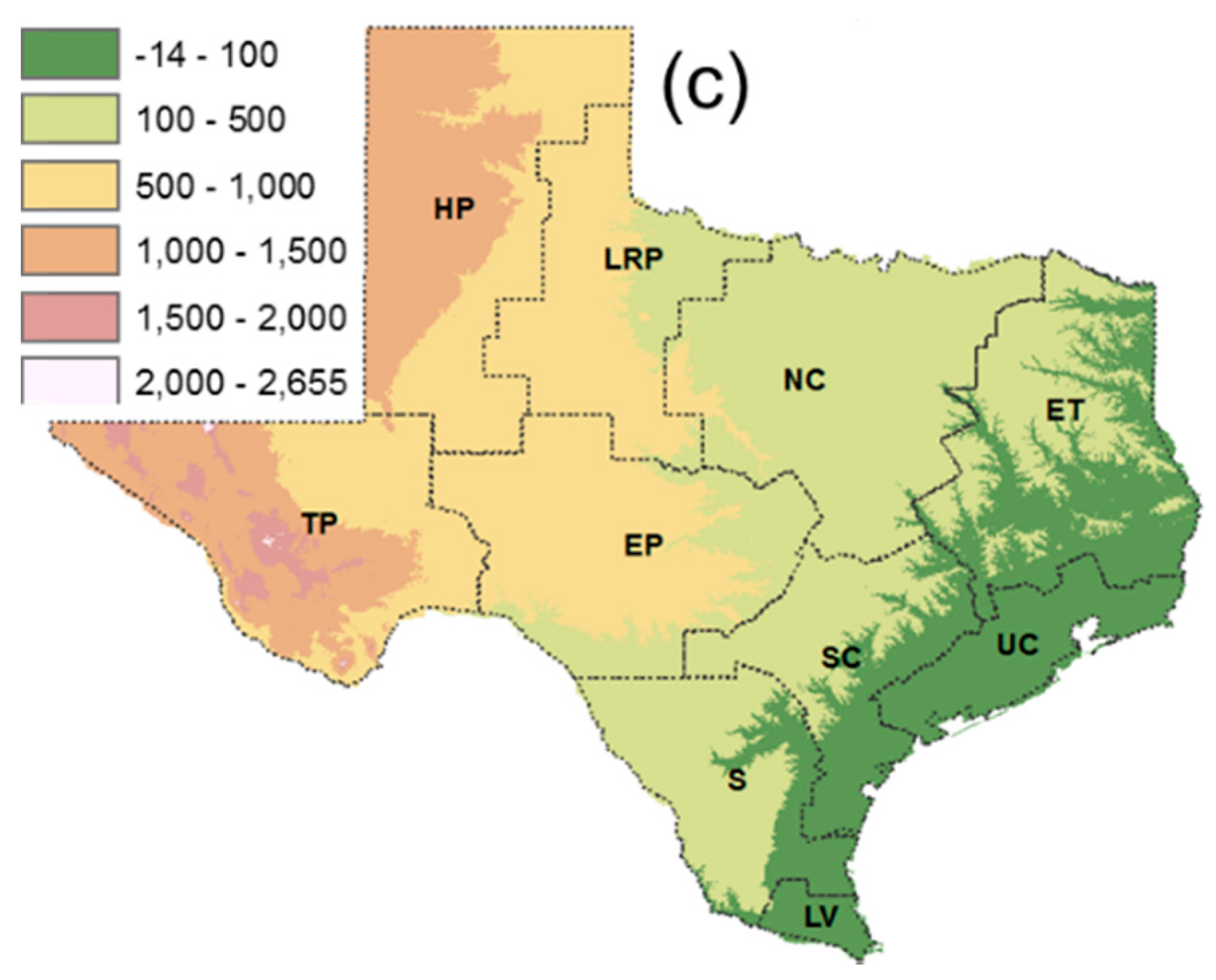
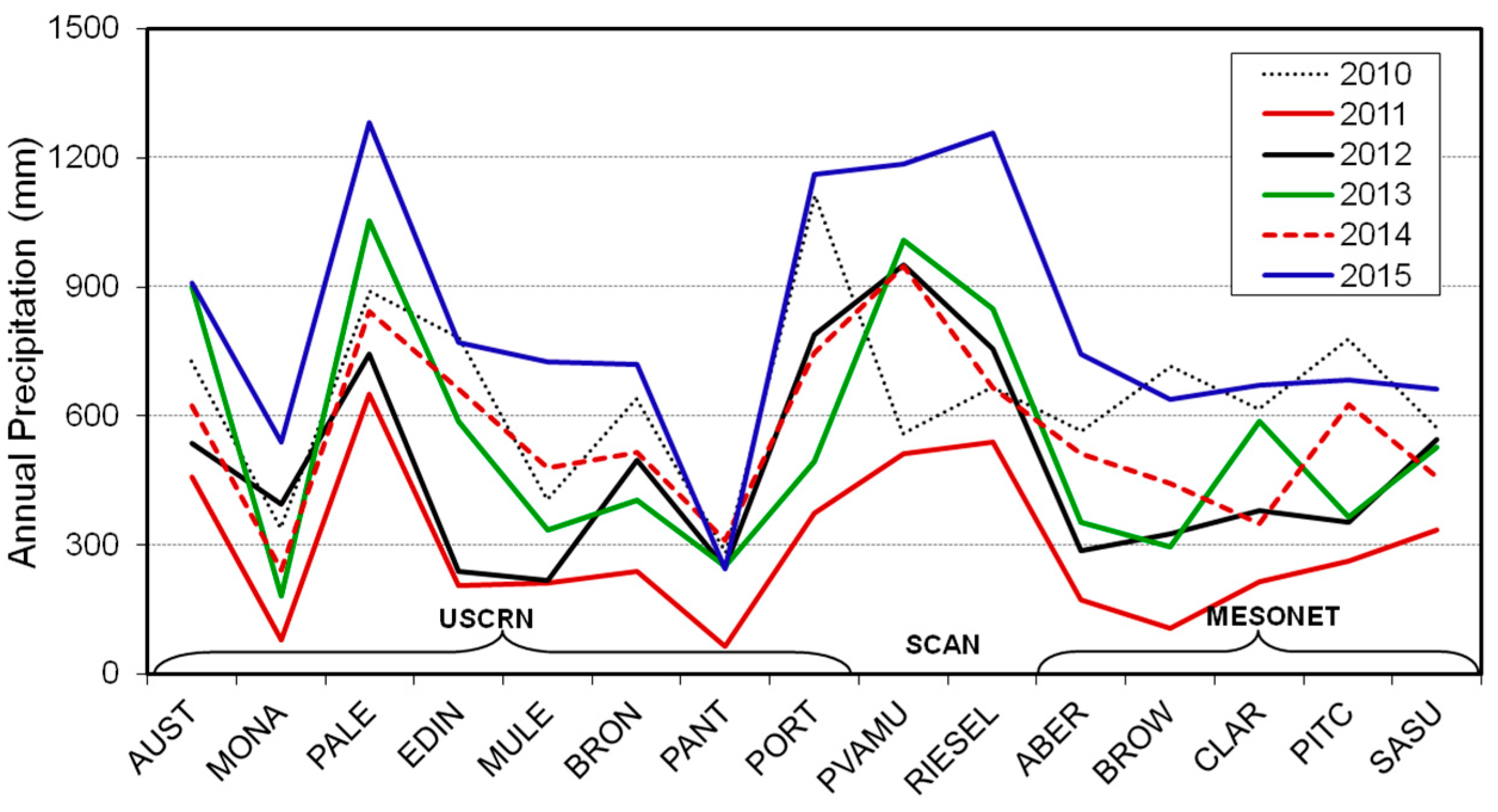
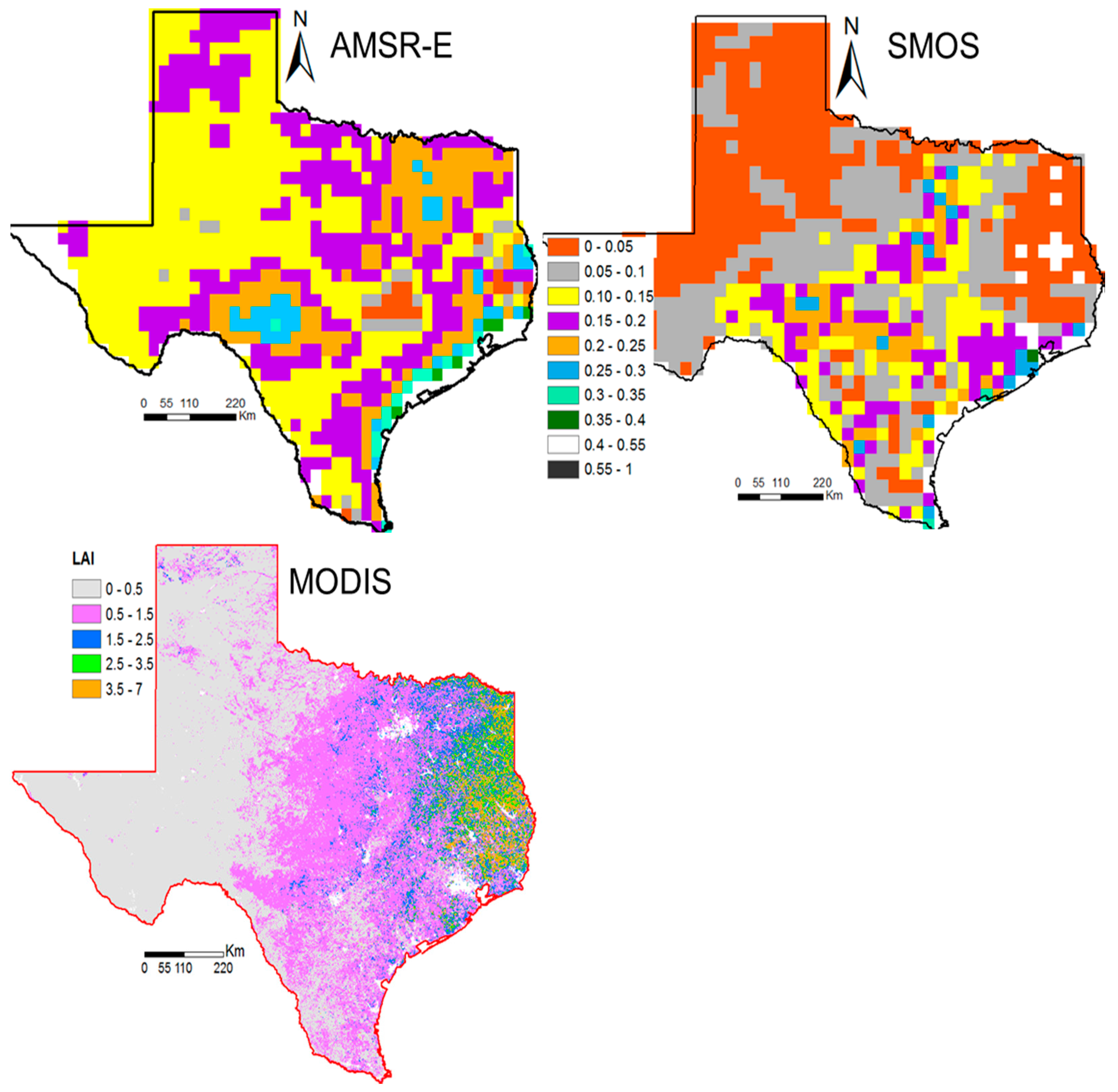

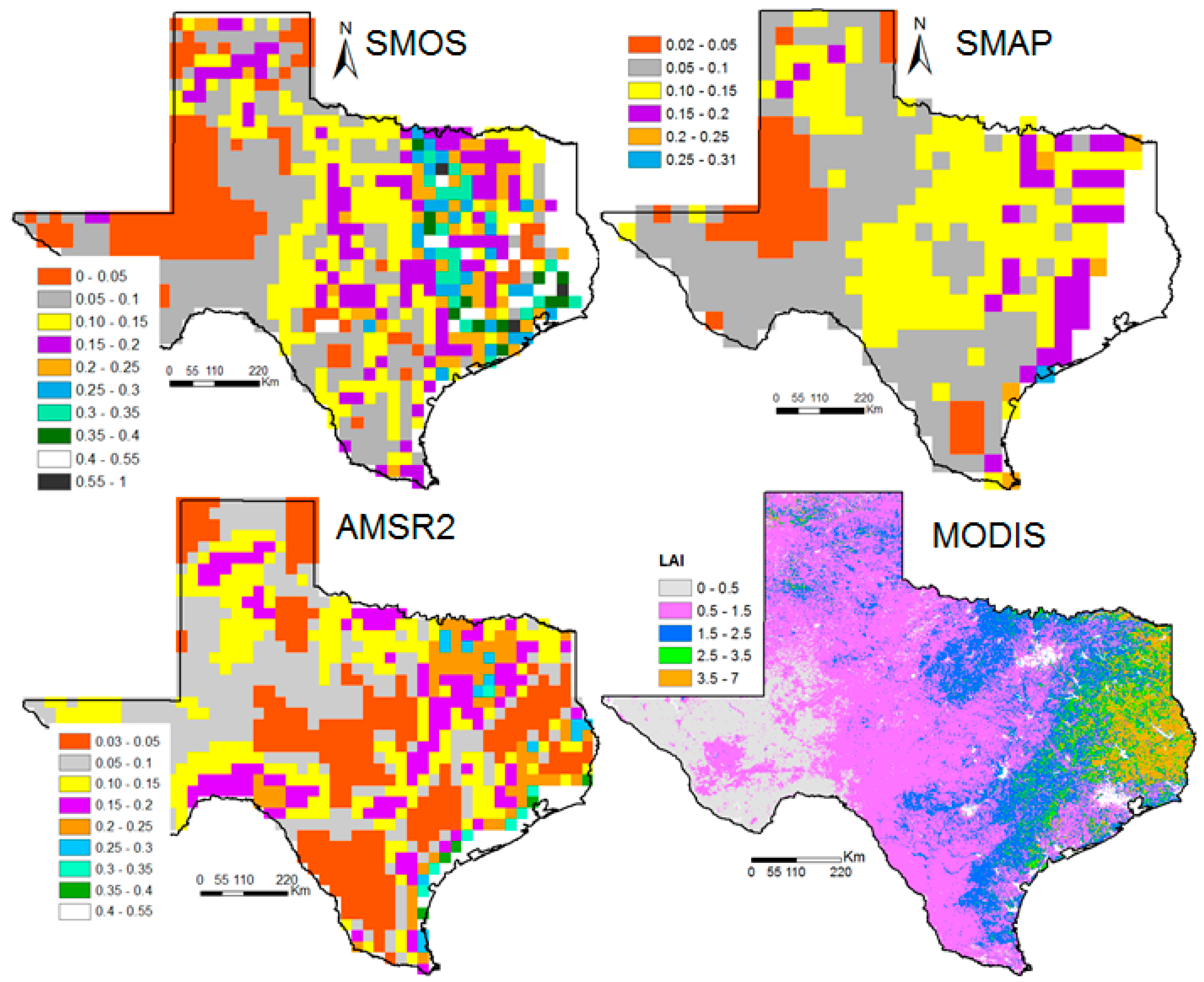
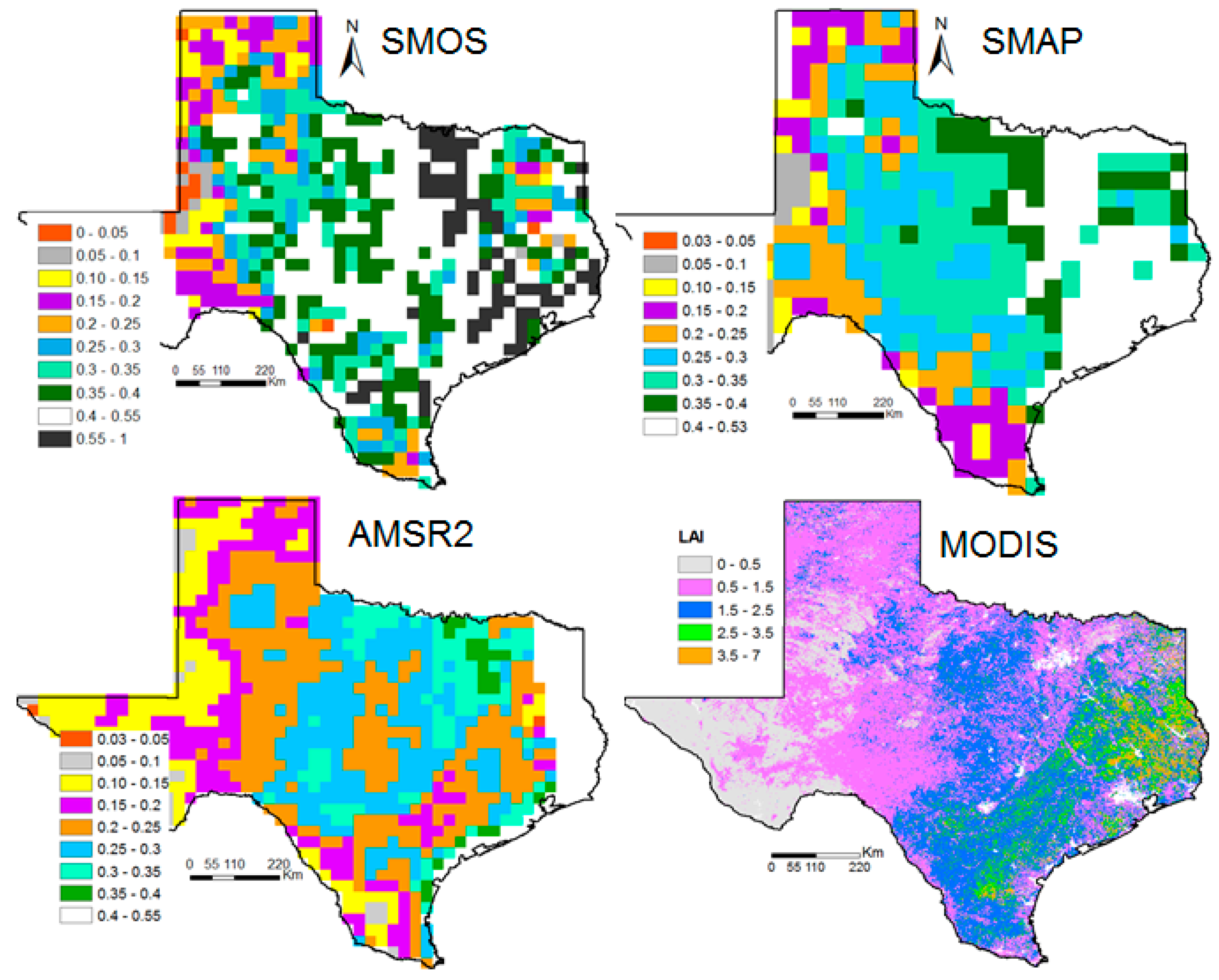
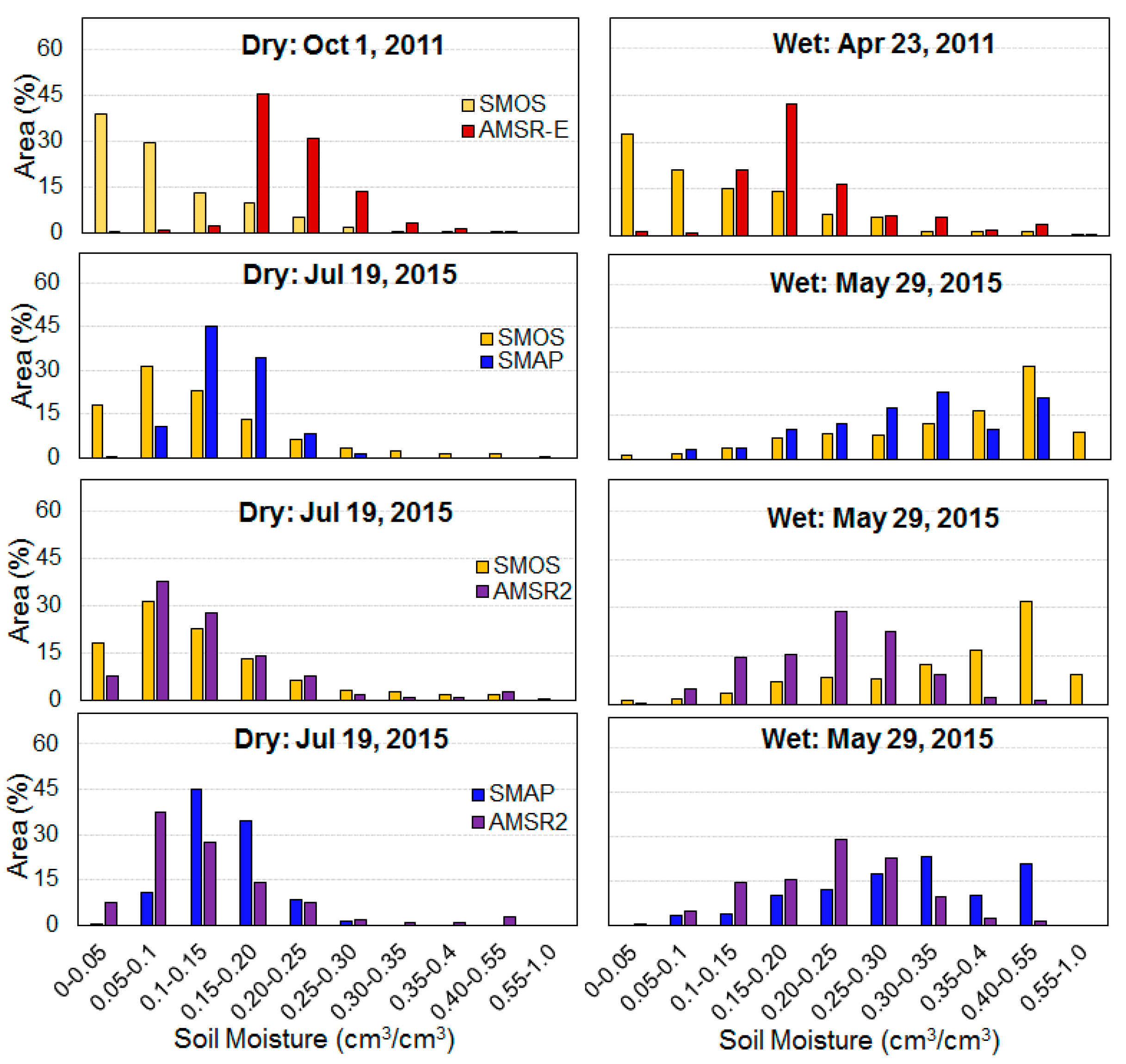
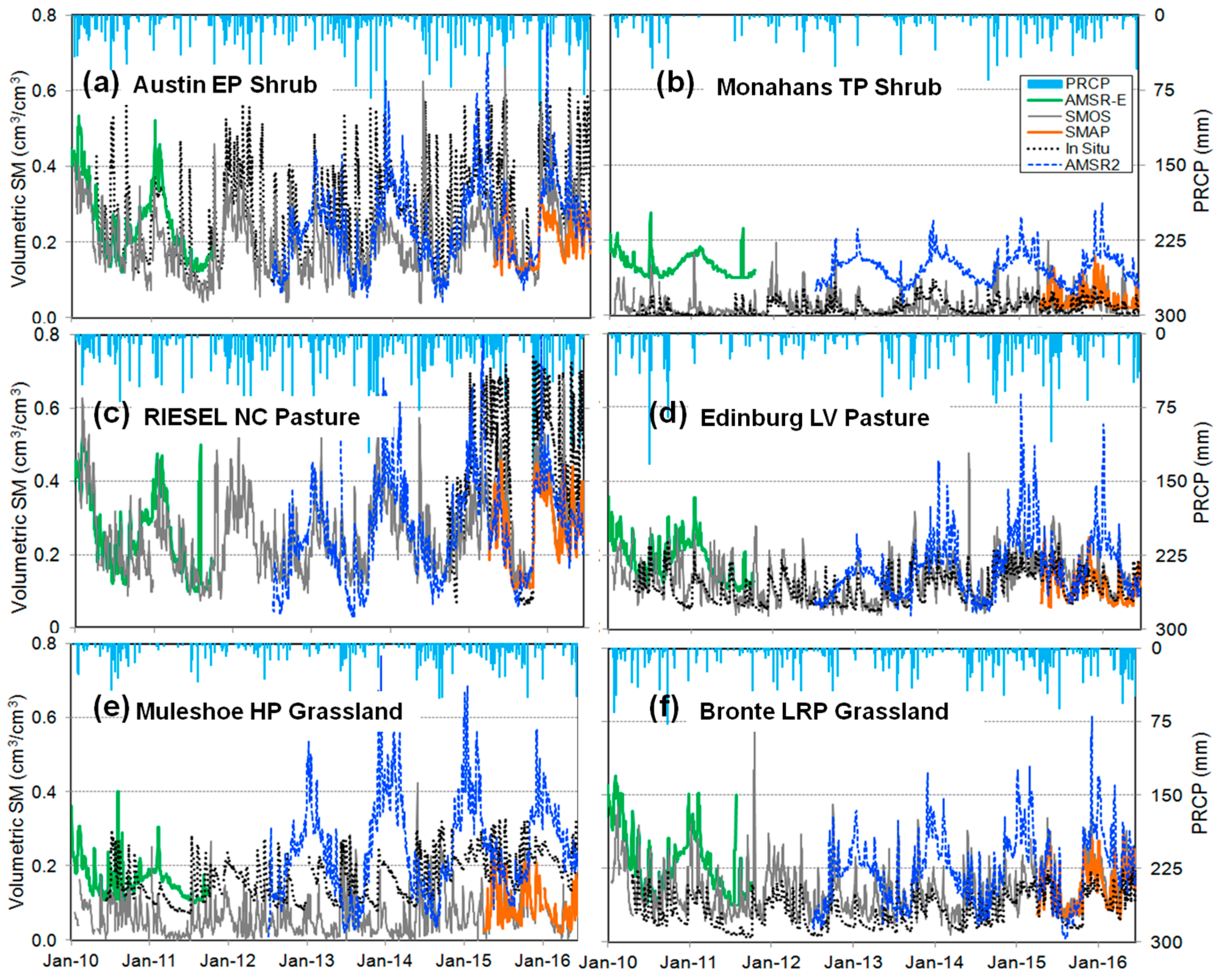
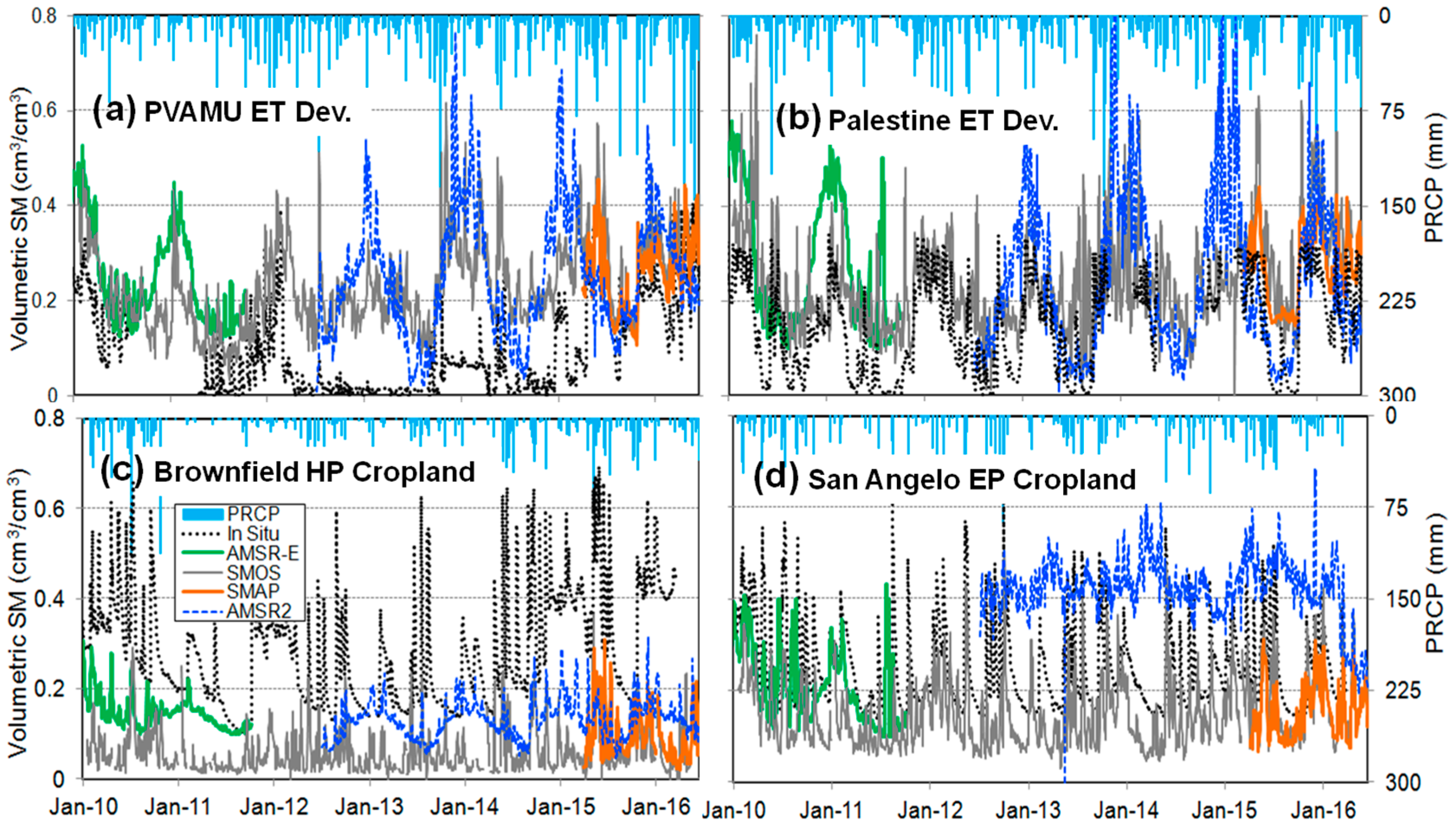
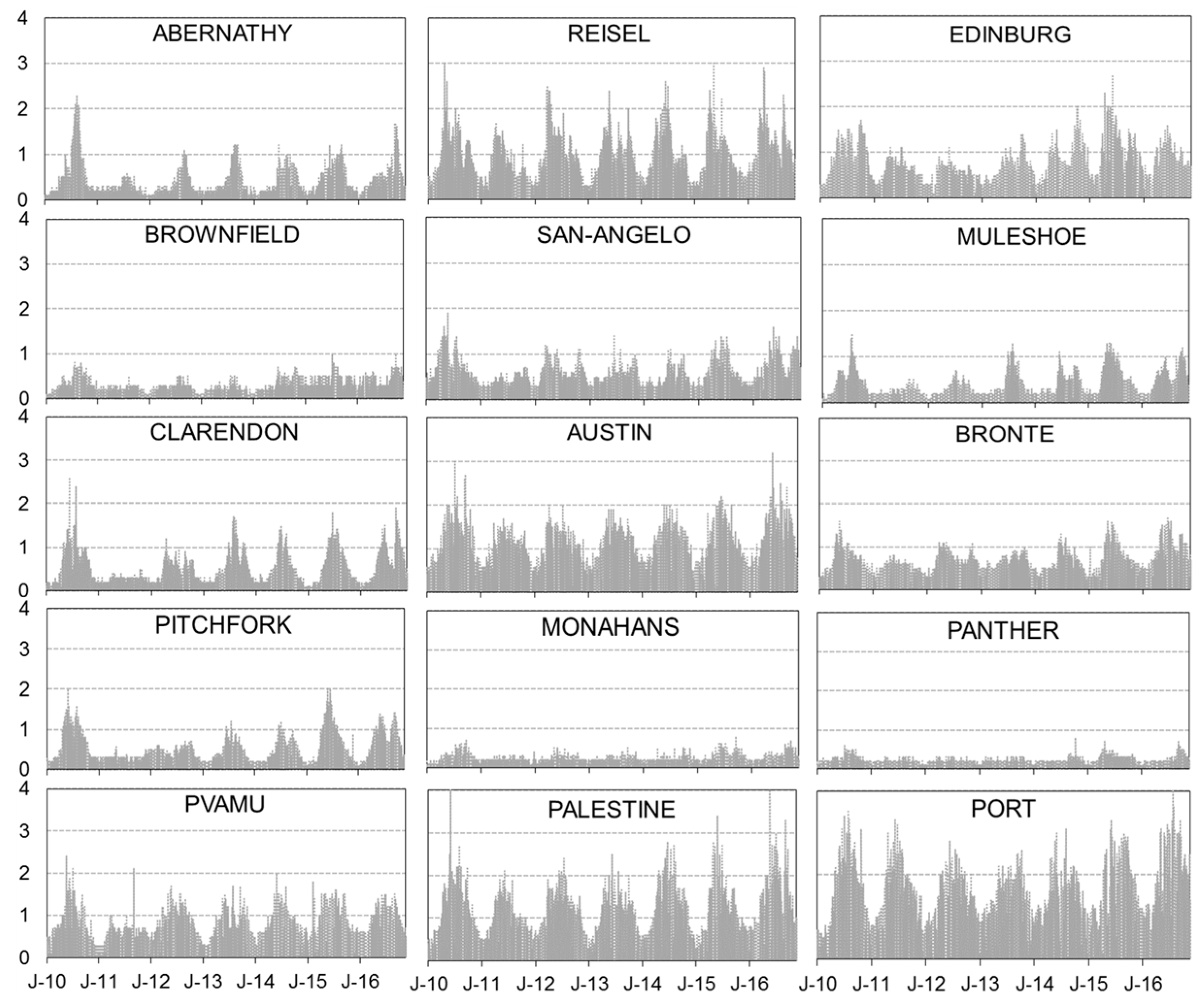
| Parameter | AMSR-E | SMOS | AMSR2 | SMAP |
|---|---|---|---|---|
| Launch date | 2002–2011 | 2009 | 2012 | 2015 |
| Frequency (GHz) | 6.6, 10.65, 18.7, 23.8, 36.5 & 89 | 1.4 | 6.93, 7.3, 10.65, 18.7, 23.8, 36.5 & 89 | 1.41 |
| Polarization | H & V | H & V | H & V | H, V & HV or VH |
| Swath width (km) | 1445 | 1000 | 1450 | 1000 |
| Revisit coverage (days) | 2 | 3 | 2 | 3 |
| Soil Moisture Bands | C & X | L | C1, C2 & X | L |
| Spatial Resolution (km) | 25 | 25 | 25 | 36 |
| Ascending/Descending | Ascending | Ascending | Ascending | Descending |
| Local Passing Time | 1.30 p.m. | 6.00 a.m. | 1.30 p.m. | 6.00 a.m. |
| SN | Station | Lat (°) | Long (°) | Elev. (m) | Soil | Land Cover | Climate Zone |
|---|---|---|---|---|---|---|---|
| 1 | Abernathy | 33.88 | −101.76 | 1016 | CL | Grassland | High Plains (HP) |
| 2 | Brownfield | 33.15 | −102.27 | 1010 | S | Cropland | High Plains (HP) |
| 3 | Clarendon | 34.92 | −100.93 | 865 | SL | Shrub | Low Rolling Plains (LRP) |
| 4 | Pitchfork | 33.57 | −100.48 | 609 | L | Grassland | Low Rolling Plains (LRP) |
| 5 | San Angelo | 31.54 | −100.51 | 597 | SICL | Cropland | Edwards Plateau (EP) |
| 6 | PVAMU * | 30.08 | −95.98 | 82 | SL | Developed | East Texas (ET) |
| 7 | Riesel * | 31.48 | −96.88 | 164 | C | Pasture | North Central (NC) |
| 8 | Austin ** | 30.62 | −98.08 | 415 | CL | Shrub | Edwards Plateau (EP) |
| 9 | Bronte ** | 32.04 | −100.25 | 609 | SL | Grassland | Low Rolling Plains (LRP) |
| 10 | Edinburg ** | 26.53 | −98.06 | 20 | S | Pasture | Lower Valley (LV) |
| 11 | Monahans ** | 31.62 | −102.81 | 830 | S | Shrub | Trans Pecos (TP) |
| 12 | Muleshoe ** | 33.96 | −102.77 | 1141 | L | Grassland | High Plains (HP) |
| 13 | Palestine ** | 31.78 | −95.72 | 117 | S | Developed | East Texas (ET) |
| 14 | Panther ** | 29.35 | −103.21 | 1066 | SL | Shrub | Trans Pecos (TP) |
| 15 | Port-Aransas ** | 28.30 | −96.82 | 5 | S | Deciduous Forest | Upper Coast (UC) |
| Correlation Coefficient (R) among In Situ and Satellite Observations | |||||||
|---|---|---|---|---|---|---|---|
| Station Name | AMSR-E | AMSR2 | SMOS | SMAP | Elev. (m) | Soil Texture | Land Cover |
| Abernathy | 0.35 | 0.42 | 0.53 | 0.60 | 1016 | Clay Loam | Grassland |
| Brownfield | 0.24 | 0.33 | 0.36 | 0.45 | 1010 | Sand | Cropland |
| Clarendon | 0.44 | 0.57 | 0.24 | 0.75 | 865 | Sandy Loam | Shrub |
| Pitchfork Ranch | 0.20 | 0.57 | 0.65 | 0.88 | 609 | Loam | Grassland |
| Prairie View | 0.61 | 0.14 | 0.45 | 0.77 | 82 | Sandy Loam | Developed |
| Riesel | N/A | 0.60 | 0.78 | 0.89 | 164 | Clay | Pasture-Hay |
| Austin | 0.62 | 0.62 | 0.71 | 0.92 | 415 | Clay Loam | Shrub |
| Bronte | 0.63 | 0.60 | 0.65 | 0.84 | 609 | Sandy Loam | Grassland |
| Edinburg | 0.34 | 0.48 | 0.63 | 0.74 | 20 | Sand | Pasture |
| Monahans | 0.05 | 0.26 | 0.26 | 0.37 | 830 | Sand | Shrub |
| Muleshoe | 0.06 | 0.39 | 0.57 | 0.77 | 1141 | Loam | Grassland |
| Palestine | 0.65 | 0.53 | 0.48 | 0.92 | 117 | Sand | Developed |
| Panther | 0.29 | 0.24 | 0.56 | 0.66 | 1066 | Sandy Loam | Shrub |
| Port-Aransas | 0.24 | 0.51 | 0.35 | 0.72 | 5 | Sand | Forest |
| San Angelo | 0.2439 | 0.07 | 0.63 | 0.66 | 597 | Silty Clay Loam | Cropland |
| Correlation Coefficient (R) | |||||
|---|---|---|---|---|---|
| Station Name | Short Name | AMSR-E–SMOS | SMOS–SMAP | SMOS–AMSR2 | SMAP–AMSR2 |
| Abernathy | ABER | 0.35 | 0.87 | 0.55 | 0.75 |
| Brownfield | BROW | 0.46 | 0.78 | 0.50 | 0.61 |
| Clarendon | CLAR | 0.12 | 0.44 | 0.17 | 0.70 |
| Pitchfork Ranch | PITC | 0.0.03 | 0.83 | 0.54 | 0.78 |
| Prairie View | PVAMU | 0.66 | 0.87 | 0.41 | 0.46 |
| Riesel | RIESEL | 0.59 | 0.89 | 0.59 | 0.80 |
| Austin | AUST | 0.61 | 0.88 | 0.47 | 0.66 |
| Bronte | BRON | 0.52 | 0.88 | 0.54 | 0.74 |
| Edinburg | EDIN | 0.53 | 0.74 | 0.35 | 0.39 |
| Monahans | MONA | 0.27 | 0.91 | 0.32 | 0.46 |
| Muleshoe | MULE | 0.26 | 0.83 | 0.45 | 0.65 |
| Palestine | PALE | 0.30 | 0.69 | 0.14 | 0.46 |
| Panther | PANT | 0.0.03 | 0.73 | 0.22 | 0.10 |
| Port-Aransas | PORT | 0.17 | 0.66 | 0.24 | 0.24 |
| San Angelo | SASU | 0.32 | 0.71 | 0.10 | 0.10 |
| Root Mean Square Error (RMSE) | ||||||||
|---|---|---|---|---|---|---|---|---|
| Station Name | Short Name | 2010–2011 | 2012–2016 | 2015–2016 | ||||
| AMSR-E | SMOS | AMSR2 | SMOS | SMAP | AMSR2 | SMOS | ||
| Abernathy | ABER | 0.11 | 0.14 | 0.10 | 0.10 | 0.11 | 0.09 | 0.11 |
| Brownfield | BROW | 0.11 | 0.23 | 0.20 | 0.27 | 0.29 | 0.26 | 0.32 |
| Clarendon | CLAR | 0.08 | 0.17 | 0.09 | 0.15 | 0.09 | 0.08 | 0.16 |
| Pitchfork Ranch | PITC | 0.10 | 0.11 | 0.10 | 0.12 | 0.12 | 0.09 | 0.12 |
| Prairie View | PVAMU | 0.12 | 0.10 | 0.24 | 0.20 | 0.08 | 0.13 | 0.13 |
| Riesel | RIESEL | 0.19 | 0.19 | 0.19 | 0.21 | 0.18 | ||
| Austin | AUST | 0.08 | 0.09 | 0.12 | 0.12 | 0.14 | 0.13 | 0.11 |
| Bronte | BRON | 0.13 | 0.10 | 0.14 | 0.08 | 0.06 | 0.13 | 0.09 |
| Edinburg | EDIN | 0.09 | 0.06 | 0.10 | 0.06 | 0.03 | 0.09 | 0.06 |
| Monahans | MONA | 0.12 | 0.04 | 0.11 | 0.04 | 0.04 | 0.10 | 0.05 |
| Muleshoe | MULE | 0.08 | 0.11 | 0.15 | 0.12 | 0.13 | 0.11 | 0.14 |
| Palestine | PALE | 0.17 | 0.17 | 0.15 | 0.18 | 0.12 | 0.15 | 0.20 |
| Panther | PANT | 0.14 | 0.05 | 0.11 | 0.05 | 0.02 | 0.10 | 0.03 |
| Port-Aransas | PORT | 0.37 | 0.28 | 0.41 | 0.32 | 0.35 | 0.47 | 0.29 |
| San Angelo | SASU | 0.11 | 0.14 | 0.22 | 0.12 | 0.11 | 0.23 | 0.11 |
| Average | 0.13 | 0.13 | 0.16 | 0.14 | 0.13 | 0.16 | 0.14 | |
© 2017 by the authors. Licensee MDPI, Basel, Switzerland. This article is an open access article distributed under the terms and conditions of the Creative Commons Attribution (CC BY) license (http://creativecommons.org/licenses/by/4.0/).
Share and Cite
Ray, R.L.; Fares, A.; He, Y.; Temimi, M. Evaluation and Inter-Comparison of Satellite Soil Moisture Products Using In Situ Observations over Texas, U.S. Water 2017, 9, 372. https://doi.org/10.3390/w9060372
Ray RL, Fares A, He Y, Temimi M. Evaluation and Inter-Comparison of Satellite Soil Moisture Products Using In Situ Observations over Texas, U.S. Water. 2017; 9(6):372. https://doi.org/10.3390/w9060372
Chicago/Turabian StyleRay, Ram L., Ali Fares, Yiping He, and Marouane Temimi. 2017. "Evaluation and Inter-Comparison of Satellite Soil Moisture Products Using In Situ Observations over Texas, U.S." Water 9, no. 6: 372. https://doi.org/10.3390/w9060372
APA StyleRay, R. L., Fares, A., He, Y., & Temimi, M. (2017). Evaluation and Inter-Comparison of Satellite Soil Moisture Products Using In Situ Observations over Texas, U.S. Water, 9(6), 372. https://doi.org/10.3390/w9060372







